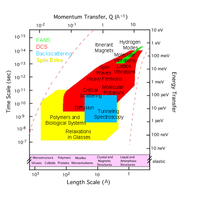Spectroscopy

The energy scale of the neutrons produced at the NCNR (meV's) makes them ideal probes of the dynamics of materials. At the same time, the wavelength of these neutrons is comparable to interatomic spacings. This combination allows scientists to determine geometrical aspects of motions on the atomic scale in a way that is unmatched by other spectroscopic probes.
The neutron spectrometers at the NCNR allow researchers to ascertain dynamical properties over 7 orders of magnitude in energy ranging from ~20 neV to 200 meV, which corresponds to time scales from 100 nanoseconds to ~10 femtoseconds (see figure). This allows researchers to study a wide variety of dynamical processes in materials, from the vibrations, rotations, tunneling and diffusive motions of atoms, molecules, and macromolecules, to solid state excitations such as spin waves, phonons, and magnetic excitons.
Seven neutron scattering instruments capable of measuring the dynamics of materials are currently being operated at the NCNR. Three of these instruments belong to the Center for High Resolution Neutron Scattering (CHRNS) which is supported by a grant from the National Science Foundation.
- Thermal Neutron Double-focusing Triple Axis Spectrometer -BT7
- SPINS- Cold Neutron Triple Axis Spectrometer - NG5
- FANS- Thermal Neutron Vibrational Spectrometer - BT4
- DCS - Cold Neutron Disk Chopper Time-of-Flight Spectrometer - NG4
- HFBS- Cold Neutron Backscattering Spectrometer - NG2 (CHRNS)
- NSE- Cold Neutron Spin Echo Spectrometer - NGA (CHRNS)
- MACS- Cold Neutron Triple Axis Spectrometer - BT9 (CHRNS)
Contacts
-
(301) 975-5134

